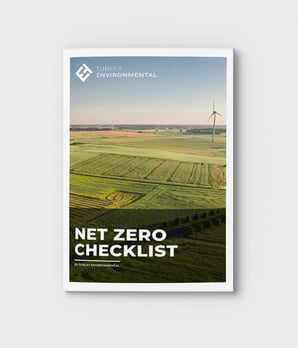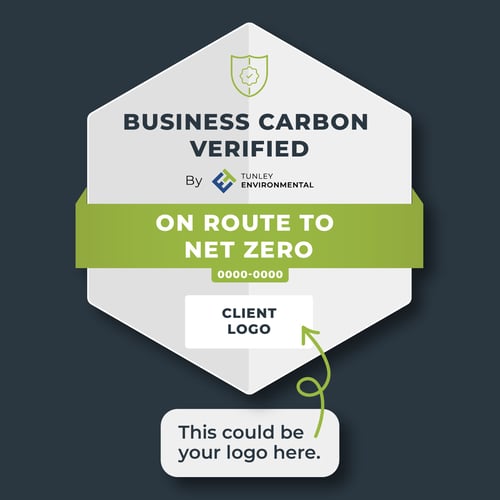Net zero carbon refers to the state in which greenhouse gas (GHG) emissions are reduced to as close to zero as possible, with any remaining emissions being offset by activities that remove carbon dioxide from the atmosphere.
According to the National Centre for Atmospheric Science “2023 is anticipated to be the warmest year on record after numerous temperature records have been broken”. Why do rising temperatures matter? Several types of extreme weather, including heatwaves, heavy downpours, hurricanes and wildfires are becoming stronger and more dangerous, which will make life on earth become more difficult and unsafe for all of its inhabitants. It is clear that we need to take immediate and impactful climate action.
One of the key objectives in our sustainability agenda is achieving net zero carbon emissions. We will delve into the meaning of net zero emissions, why it is important, and provide practical strategies for businesses to achieve this goal.

Click here to download our Net Zero Strategy Checklist.
What is Net Zero Carbon?
Net zero carbon refers to the state in which greenhouse gas (GHG) emissions are reduced to as close to zero as possible, with any remaining emissions being offset by activities that remove carbon dioxide from the atmosphere (carbon credits/offsets are the final resort for emissions that can’t be removed). Achieving net zero carbon requires a multi-faceted approach that involves reducing emissions across scopes 1, 2, and 3 by setting science-based targets, and implementing decarbonisation pathways.
According to the Intergovernmental Panel on Climate Change (IPCC), net zero emissions are achieved when anthropogenic (human initiated) removals balance anthropogenic emissions of greenhouse gases over a specified period. The quantification of greenhouse gas emissions is, carried out in accordance with the Greenhouse Gas Protocol and ISO 14064-1, capturing direct and indirect emissions from business activities performed by the reporting company and third party entities in their value chain.
Why Reaching Net Zero is Important
The urgency to reach net zero emissions stems from the need to limit global warming to under 1.5°C. The latest climate science has reinforced that exceeding this threshold will result in devastating impacts on our planet. To avoid these catastrophic consequences, the United nations have stated “to keep global warming to no more than 1.5°C – as called for in the Paris Agreement – emissions need to be reduced by 45% by 2030 and reach net zero by 2050.”
Reaching net zero carbon emissions is not just an environmental imperative; it is also a business imperative. Customers, investors, and stakeholders are increasingly demanding sustainable practices and transparency in emissions reduction efforts. By committing to and achieving net zero carbon, businesses can enhance their reputation, attract socially conscious consumers, and contribute to a more sustainable future.
Data Collection
Before embarking on the journey to net zero, it is essential to understand your current carbon footprint. This involves comprehensive data collection and analysis to determine the sources and levels of your emissions. By conducting a thorough carbon footprint assessment, businesses can highlight emission hotspots, identify areas of improvement and set realistic targets for emissions reduction.
Data collection should cover scopes 1, 2, and 3 emissions. Scope 1 refers to direct emissions from owned or controlled sources, such as on-site fuel combustion. Scope 2 includes indirect emissions from purchased electricity and heat. Scope 3 encompasses a broader range of indirect emissions, including those from the supply chain, employee commuting, and business travel.
Scopes 1, 2, and 3 Outlined
To effectively reduce emissions, businesses must understand the distinctions between scopes 1, 2, and 3. Scope 1 emissions are the most direct and controllable, as they originate from sources owned or controlled by the business. Examples include emissions from manufacturing processes, on-site fuel combustion, and company-owned vehicles.
Scope 2 emissions are indirect emissions resulting from the generation of purchased electricity, heat, or steam consumed by the business. These emissions are not directly controlled by the organisation but can be influenced through renewable energy procurement and energy efficiency measures.
Scope 3 emissions are the most challenging to address, as they encompass a wide range of indirect emissions that occur throughout the value chain. These emissions include those associated with purchased goods and services, transportation and distribution, waste management, and employee commuting. Tackling scope 3 emissions often requires collaboration with suppliers and partners to implement sustainable practices collectively.
Net Zero Roadmaps
To achieve net zero emissions, businesses need a clear roadmap that outlines the steps and milestones towards their goal. A net zero roadmap serves as a strategic guide, providing a structured approach to emissions reduction and carbon neutrality. Here are some key components of an effective net zero roadmap:
- Setting Science-Based Targets: Science-based targets ensure that emissions reduction goals are aligned with the latest climate science. These targets are based on the level of decarbonisation required to limit global warming to 1.5°C or well below 2°C. By adopting science-based targets, businesses can demonstrate their commitment to ambitious and credible emissions reduction.
- Decarbonisation Pathways: Developing decarbonisation pathways is crucial for businesses to identify and implement the most effective strategies for emissions reduction. These pathways may include transitioning to renewable energy sources, energy efficiency improvements, process optimisation, and the adoption of low-carbon technologies.
- Carbon Capture, Storage, and Sequestration: While efforts should focus on reducing emissions, some emissions may be challenging to eliminate entirely. In such cases, carbon capture, storage, and sequestration (CCS) technologies can play a crucial role. CCS involves capturing carbon dioxide emissions from industrial processes and storing them underground or utilising them in other applications.
- Beyond Value Chain Mitigation: Achieving net zero emissions may require offsetting residual emissions that cannot be eliminated through other means. Beyond value chain mitigation involves investing in projects that remove or reduce carbon dioxide from the atmosphere, such as reforestation, afforestation, and carbon capture projects.
Implementing Your Net Zero Strategy
Implementing a net zero strategy requires a holistic and integrated approach that involves multiple stakeholders within the organisation. Here are some key steps to consider when implementing your net zero strategy:
- Engage Leadership and Stakeholders: Securing buy-in and commitment from senior leadership is crucial for the success of your net zero strategy. Engage stakeholders throughout the organisation to ensure alignment and support for emissions reduction initiatives.
- Establish Clear Roles and Responsibilities: Assign clear roles and responsibilities to individuals or teams responsible for implementing and monitoring emissions reduction efforts. This ensures accountability and fosters a sense of ownership among employees.
- Invest in Technology and Infrastructure: Assess your technology and infrastructure needs to support emissions reduction initiatives. This may involve investing in energy-efficient equipment, renewable energy systems, and data monitoring and reporting tools.
- Collaborate with Suppliers and Partners: Engage with your supply chain partners to promote sustainability and emissions reduction throughout the value chain. Collaborate on initiatives such as responsible sourcing, transportation optimisation, and waste reduction.
- Monitor, Measure, and Report: Establish robust monitoring and measurement systems to track progress towards emissions reduction targets. Regularly report on your emissions performance to stakeholders, demonstrating transparency and accountability.
- Continual Improvement: Achieving net zero emissions is an ongoing journey. Continually evaluate and refine your net zero strategy to adapt to changing technologies, market trends, and regulatory requirements.
Ensuring that implementation is thorough can be difficult to keep track of. Leaning on experts who can guide you through the process is advised. This is also beneficial when it comes to verification of your net zero status. Organisations such as Tunley can provide that third-party verification for you, as well as helping to engage your stakeholders, gather data, create your roadmap, among several other initiatives – taking the weight straight off your shoulders.
The Bottom Line
Achieving net zero carbon emissions is an urgent and critical goal for businesses and society as a whole. By understanding the meaning of net zero emissions and implementing effective strategies, businesses can contribute to a more sustainable future. It is not just an environmental imperative but also a business imperative, as it enhances reputation, attracts socially conscious consumers, and aligns with global sustainability goals. With a clear roadmap, commitment from leadership, and collaboration across the value chain, businesses can successfully achieve net zero carbon and create a positive impact on the planet. Start your journey towards net zero emissions today and make a significant difference for future generations.



